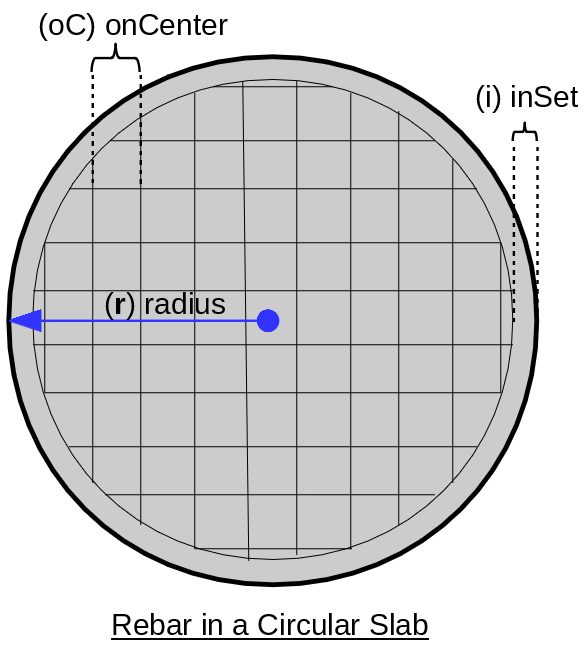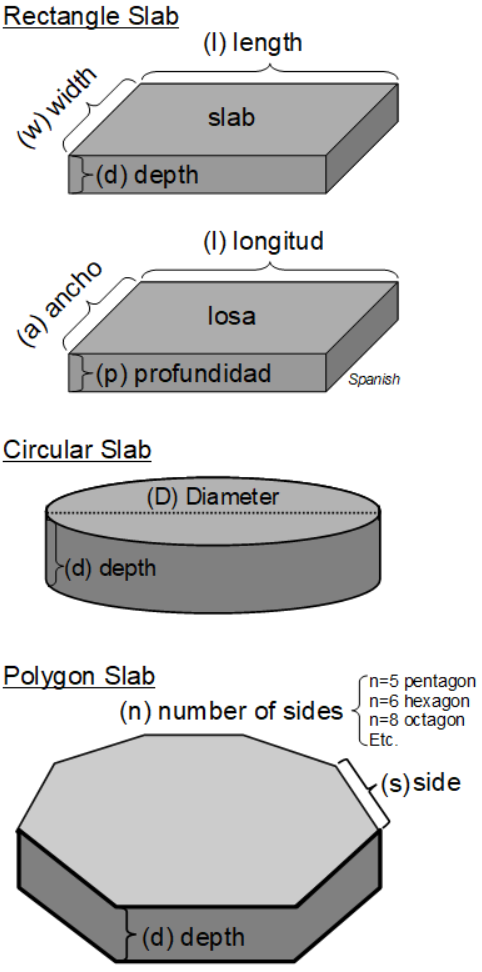The Rebar in a Circular Shaped Slab calculator estimates the total length and weight of reinforcement bars (rebar) needed for a circular shaped concrete slab.
INSTRUCTIONS: Choose units and enter the following:
- (r) Radius of Circular Slab (e.g. 12 ft).
- (D) Depth of Slab (e.g. 6")
- (i) Inset from the edge of the circular slab (e.g. 3 inches)
- (oC) on-center spacing of the rebar.
- (rS) Rebar Size
- (LF) Lapping Factor
- (M) Number of rebar mats
- (rL) un-cut Rebar Length
- Details Option
Weight and Length of Rebar in a Circular Slab: The calculator returns the length of rebar in feet, and the weight rebar in pounds. However, these can be automatically converted to compatible units via the pull-down menu. If details are chosen ("YES"), the calculator also returns the following:
- Surface Area of Slab in square feet
- Total Volume of the Slab in cubic yards
- Volume of Concrete in cubic yards
- Concrete Displaced by Rebar in cubic yards
However, these to can be automatically converted to compatible units (e.g. meters or kilograms) via the pull-down menu.
The Math / Science
The rebar in a circular slab algorithm starts with the center lines (horizontal and vertical) and works outward.
Circular Concrete Slab Calculators
- Rebar in Circular Slab: Computes the length and weight of rebar in a circular slab based on the dimensions, spacing, number of mats, rebar size, rebar stick length and lapping factor.
- Circular Slab Surface Area: Computes the surface area of a circular slab based on the diameter.
- Circular Slab Circumference: Computes the perimeter (circumference) of a circular slab base on the diameter.
- Volume of Circular Slab: Computes the cubic yards (volume) of concrete a circular slab based on the diameter and depth.
- Circular Slab Weight: Computes weight of a circular slab of concrete based on the diameter, depth and the mean density of concrete.
- Circular Slab Circumference from Area: Computes the circumference of a circular slab based on the surface area of the slab.
- Semi-circle Slab Volume: Computes the volume of concrete in a semicircular shaped slab based on the radius and the depth.
- Semi-Circle Slab Weight: Computes the weight or mass of a semicircular shaped concrete slab based on the radius, the depth and mean density of concrete.
General Rebar Information
Rebar is short for reinforcing bar. Rebar is a roughly circular steel bar with ribs used to provide added tensile strength to concrete structures. Rebar is put in place before concrete is poured. When the concrete has hardened, the concrete around the rebar ribs keep the rebar in place. Rebar and concrete expand similarly with temperature variations. This all has the net result of substantially added tensile strength when rebar is part of the concrete form. Carbon steel is the most commonly used material for rebar, which may also be coated with zinc or epoxy resin.
Rebar is laid out in grids, crisscrossed patterns of rebar, tied at the intersections where runs of rebar touch. The grids have spacing between the rebar rows, and they are placed within the concrete form by a specified inset from the edge of the concrete. Multiple parallel grids, at uniform space intervals, are referred to as rebar mats.
Rebar Terms
- Rebar - reinforcing steel bar.
- Stick - one length of rebar. In the U.S., the most common lengths of rebar sticks are 20', 40' and 60'.
- Lapping - when two sticks of rebar are overlapped and bound together.
- Lapping Factor - the multiple of a rebar diameter used to specify appropriate rebar lapping length.
- Mat - a crisscross grid of rebar sticks. There may be more than one mat with space in between mats.
- Size - the indicator of the diameter of rebar sticks. Note: guage is not a correct term for rebar.
Rebar Size
In the United States, rebar sizes are in increments of 1/8th inches in diameter. Therefore, size 4 is 4/8th of an inch, which is 1/2", and size 8 is a full inch in diameter. Based on this and the density of steel used in rebar, the Rebar Size Table contains reasonably accurate specifications of rebar linear weight and lateral (face) area based on rebar size.
Rebar Lapping

The most common lengths of pre-cut rebar in the United States are 20`, 40' and 60'. These are known as rebar sticks. When the dimensions of a slab, wall or other form exceed the length of a single stick of rebar, it is required to overlap and tie rebar pieces to create the added length. This process is called lapping, and the length of the overlapping rebar is the rebar lapping length. The length of the lap is specified by a "Lapping Factor (LF)" which is often 40 or 60 times the diameter of the rebar. Engineering specifications of a lapping factor should always be applied.
Rebar Tools
A class of rebar tools, both powered and manual, have been developed to aid construction workers in working with rebar. These include the following:
- Rebar Cutters are used to cleanly and safely cut sections of rebar.
- Rebar Benders are used to bend rebar sticks precisely to fit into concrete forms.
- Rebar Tiers are used to tie rebar grid intersections and for rebar lapping.
Concrete Slab Calculators
The following functions apply to estimating the amount of concrete, rebar, form boards and water needed for concrete slabs of different shapes: rectangular with squared corners, circular including semi-circle, and polygon shapes from triangular up (e.g., pentagon for 5 sides and dodecagon for 12 sided polygon).
Rectangle Slab
- Rebar and Concrete in a Slab: Computes the total length and weight of rebar and the volume and weight of concrete needed for a rectangular slab, taking into account the concrete displaced by the rebar.
- Concrete in Rectangle Slab: Computes the volume of concrete in a rectangle (squared corners) slab based on the dimensions. It includes the volume of concrete in cubic yards and the equivalent volume in bags of concrete. It also includes the surface area, length of form boards, and the water requirement.
- Slab Weight: Computes the weight, volume of concrete and surface area of a rectangle slab based on the length, width and depth of the concrete of the slab and the density of concrete.
- Weight of Slab with Rebar: Computes the weight of a rectangle slab with rebar based on the length, width and depth of the concrete of the slab, the density of concrete and the size and spacing of rebar. It includes total weight (concrete and rebar), and the contribution of weight from rebar and concrete separately.
- Slab Area and Perimeter: Compute the surface area and perimeter of a rectangular slab based on the dimensions.
Circular Slab
- Volume of Circular Slab: Computes the slab surface area, perimeter and cubic yards of concrete in a circular slab based on the diameter and depth. It also provides, the equivalent volume in 80lb, 60lb and 40lb bags of concrete and the water requirement.
- Circular Slab Weight: This computes the weight of the concrete in a circular slab based on the diameter, depth and density of concrete.
- Rebar and Concrete in a Circular Slab: This computes the length and weight of rebar in a rectangular slab. It also computes the total weight of the slab including concrete, taking into account the concrete displaced by rebar.
- Semi-Circle Slab Volume: Computes the volume of concrete needed for a semi-circular slab based on the radius and depth.
- Semi-Circle Slab Weight: Computes the weight of concrete in a semi-circular slab based on the radius, depth and density of concrete.
Polygon Slab
- Concrete in Polygon Slab: Computes the surface area and cubic yards of concrete for a polygon slab based on the dimensions and depth. It also provides the equivalent volume of concrete in 80lb, 60lb and 40lb bags of concrete.
General Functions
- Concrete Weight: Computes the weight of a specified volume (e.g., 2.3 cubic yards) of concrete.
- Price of Delivered Concrete: Computes the price of delivered concrete based on the volume, price per cubic yard, pumping cost, delivery distance, and mileage.
- Water Needed for Concrete: Compute the amount of water needed to make a volume of concrete.
- Concrete Displaced by Rebar: Computes the volume of concrete displaced by a length of rebar based on the length and size of rebar.
